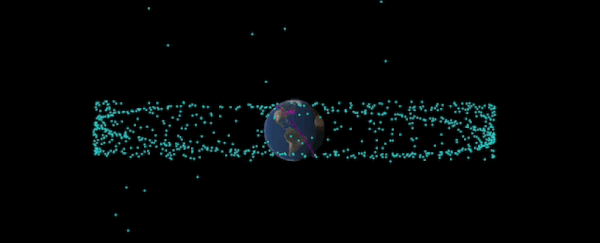It's comforting to imagine that with both space- and Earth-based telescopes trained on the cosmos, we'd be able to spot any hazardously sized asteroids heading our way a mile off, with plenty of time to paint them white or explode them away.
But for every asteroid we see coming in our direction, there's a number we miss until they fly on by.
And even for those we know about well in advance, it can still be hard to nail down just how likely an Earth collision actually is.
Asteroid 99942 Apophis is one of these asteroids, whose orbit can pass a little too close to Earth for comfort.
Discovered in 2004, the 370-metre (1,210-foot) long rocky blob is on NASA's Sentry list – a list of asteroids we should be keeping an eye on – and although scientists have crossed off any chance of it hitting during its next close flyby in 2029, they're not so sure it won't slam into us in 2068 as it comes this way again.
While the risk of Apophis hitting Earth in 2068 is somewhere in the region of 1 in 150,000, an asteroid that size would cause a blast larger than an atomic bomb, so it's best to double check the numbers.
And a presentation at the American Astronomical Society's Division for Planetary Sciences virtual conference is probably not going to make you sleep better at night.
Late last month, astronomer David Tholen from the University of Hawaii presented his and his colleague Davide Farnocchia's research after observing the asteroid for three nights in January and one night in March.
They were able to get incredibly precise information about the asteroid, and were able to detect Yarkovsky acceleration – meaning that the asteroid radiates heat more strongly on its Sun facing hemisphere than its shadow side, which causes an asymmetrical push, slightly changing its orbit.
When you work that acceleration into the asteroid's model, "that basically means that the 2068 impact scenario is still in play," explains Tholen in his presentation.
"We need to track this asteroid very carefully - obviously the 2029 close approach is critical."
The April 2029 close approach is going to be very close (closer than some of our communication satellites close) and it gives scientists a very important opportunity to study Apophis in exceptionally high detail.
And with less than nine years to go, earlier this month the Lunar and Planetary Institute held a virtual workshop to try and get that ball rolling.
"Knowledge is the first line of planetary defence, and the 2029 Apophis encounter is a once-per-thousand-year opportunity," the Lunar and Planetary Institute states.
"We have less than a decade to plan Earth-based and possible in-situ missions whose measurements can deliver unprecedented detailed knowledge on the physical nature of Apophis as the prototype example (poster child) of potentially hazardous asteroids."
If we're lucky, we might get a Bennu style mission to Apophis to explore the asteroid with a spacecraft, finding out information that telescopes alone can't hope to show us.
This asteroid "presents an excellent opportunity to prototype and demonstrate a rapid response Near Earth Orbit reconnaissance capability," Brent Barbee, an aerospace engineer from the University of Maryland explained at the conference, according to Gizmodo.
While George Dvorsky at Gizmodo outlines some of the possibilities, we're still yet to iron out what sort of scientific welcome mat we're going to give Apophis.
Whether it's a new spacecraft, a quick detour for OSIRIS-Rex, or purely ground based observations, we're about to learn a lot about our uncomfortably close neighbour – and hopefully we can confirm once and for all if Apophis is crashing at our place in 2068. Then, we can work out what to do next.
